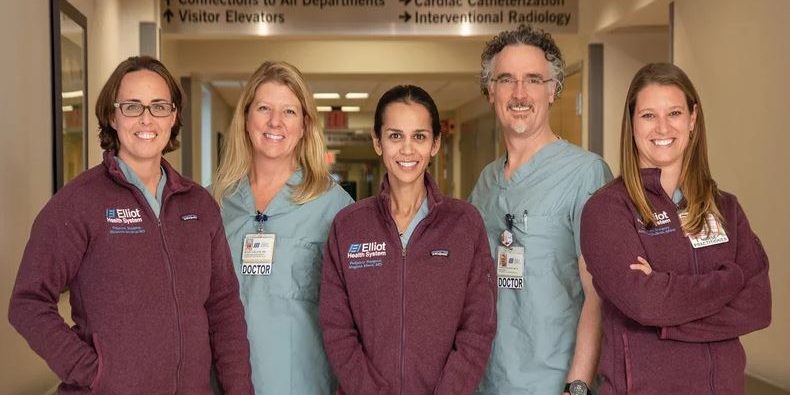Pictured above: The pediatric surgical staff at Elliot Hospital, including Dr. Elizabeth Soukup, left, and Dr. Charles Eastwood, are using spinal anesthesia for complex procedures.
General anesthesia is typically what babies receive when they need surgery, but a New Hampshire hospital is finding spinal anesthesia is a far better alternative and uses it routinely for certain complex procedures.
Although commonly used, there is debate about how safe general anesthesia is for babies. The Food and Drug Administration in 2016 issued a warning about the potential harms to brain development when using general anesthesia on children younger than 3. The agency requires warning labels on general anesthetic and sedation drugs while also stating more research is needed. But even excluding debates about whether or not general anesthesia impedes brain development, physicians at 296-bed Elliot Hospital in Manchester, N.H., prefer to use spinal anesthesia because of its benefits to the patient.
Spinal anesthesia is applied by inserting a 25-gauge needle into the patient’s back with numbing medication. The patient is awake throughout the numbing process, which takes seconds. When the effects set in after a few minutes, the baby usually falls asleep naturally during surgery. Otherwise, nurses sing the baby lullabies to keep them calm. “They tolerate this practice so beautifully—they have major surgery while taking a nap,” said Dr. Elizabeth Soukup, a pediatric surgeon at Elliot.
In comparison, general anesthesia puts babies into a medically induced coma where their natural breathing stops and a ventilator takes over. This process takes much longer, and there are more risks associated with it, said Dr. Charles Eastwood, a pediatric anesthesiologist at Elliot Hospital. With general anesthesia “if you put a child to sleep and you aren’t able to put a breathing tube in them, you are in a bad situation. If you make an error in dosage, you are in a dangerous situation,” he said. Soukup said it was a gradual process for the team at Elliot to adapt spinal anesthesia for laparoscopic surgery.
Other hospitals likely don’t use spinal anesthesia routinely because it’s not something surgeons are comfortable with, Soukup said. “It’s hard to get surgeons to change their practice or to accept a slightly wiggly baby who is awake,” she said.
Another reason surgeons may be averse to using spinal anesthesia is because the numbing effects wear off after roughly 90 minutes. If the surgeon is concerned the procedure may last longer, they are hesitant to request it, said Dr. Mary Ellen McCann, chair of the Educational Track Subcommittee on Pediatric Anesthesia at the American Society of Anesthesiologists. Some parents also aren’t comfortable with their child being awake during surgery, McCann said. Still, Soukup said parents of her patients overwhelmingly prefer the spinal anesthesia. Not only is the child not put in an induced coma, but parents can hold and play with their babies much sooner. There are risks though, McCann added. Infections can occur or the anesthesia may not work because of technical issues.
Elliot Hospital has reported strong outcomes since October 2016, which is when it began routinely monitoring data on using spinal anesthesia for more complex procedures. Of the 201 procedures performed using spinal, 99.5% were successful.
Eastwood said spinal anesthesia is an option more hospitals should consider. “We definitely have familiarity with a technique that isn’t widely used, however we feel that it could easily be adopted at any number of institutions,” he said. “We are doing this at a community hospital and showing this is a feasible, safe, effective technique. There is no reason why it couldn’t be adopted any place that was motivated to do so.”
